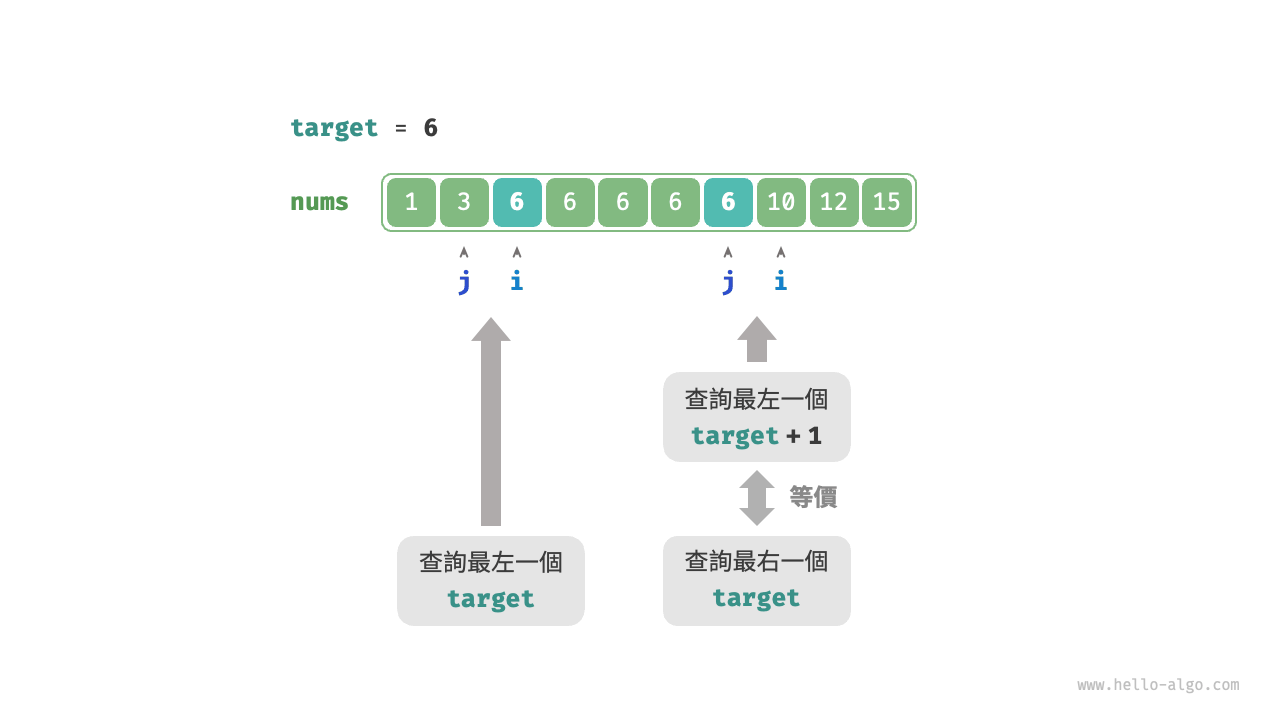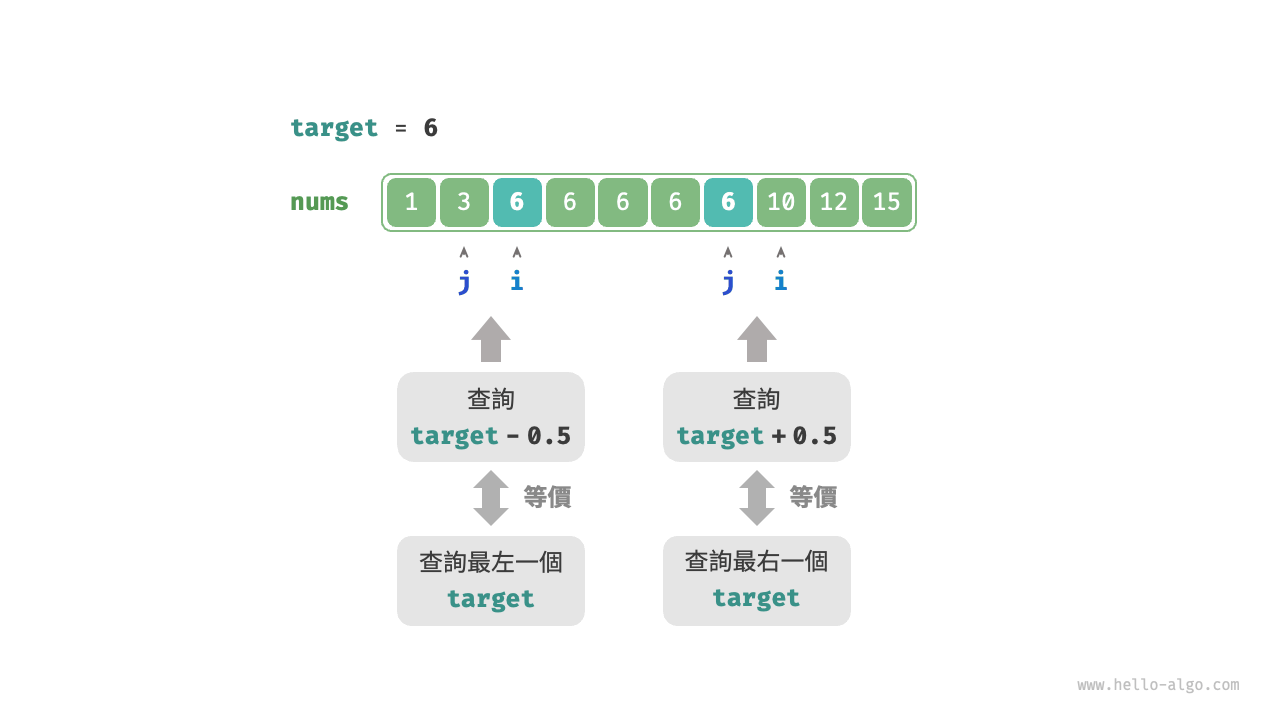10.3 二分搜尋邊界¶
10.3.1 查詢左邊界¶
Question
給定一個長度為 \(n\) 的有序陣列 nums ,其中可能包含重複元素。請返回陣列中最左一個元素 target 的索引。若陣列中不包含該元素,則返回 \(-1\) 。
回憶二分搜尋插入點的方法,搜尋完成後 \(i\) 指向最左一個 target ,因此查詢插入點本質上是在查詢最左一個 target 的索引。
考慮透過查詢插入點的函式實現查詢左邊界。請注意,陣列中可能不包含 target ,這種情況可能導致以下兩種結果。
- 插入點的索引 \(i\) 越界。
- 元素
nums[i]與target不相等。
當遇到以上兩種情況時,直接返回 \(-1\) 即可。程式碼如下所示:
binary_search_edge.ts
/* 二分搜尋最左一個 target */
function binarySearchLeftEdge(nums: Array<number>, target: number): number {
// 等價於查詢 target 的插入點
const i = binarySearchInsertion(nums, target);
// 未找到 target ,返回 -1
if (i === nums.length || nums[i] !== target) {
return -1;
}
// 找到 target ,返回索引 i
return i;
}
視覺化執行
10.3.2 查詢右邊界¶
那麼如何查詢最右一個 target 呢?最直接的方式是修改程式碼,替換在 nums[m] == target 情況下的指標收縮操作。程式碼在此省略,有興趣的讀者可以自行實現。
下面我們介紹兩種更加取巧的方法。
1. 複用查詢左邊界¶
實際上,我們可以利用查詢最左元素的函式來查詢最右元素,具體方法為:將查詢最右一個 target 轉化為查詢最左一個 target + 1。
如圖 10-7 所示,查詢完成後,指標 \(i\) 指向最左一個 target + 1(如果存在),而 \(j\) 指向最右一個 target ,因此返回 \(j\) 即可。
圖 10-7 將查詢右邊界轉化為查詢左邊界
請注意,返回的插入點是 \(i\) ,因此需要將其減 \(1\) ,從而獲得 \(j\) :
binary_search_edge.py
def binary_search_right_edge(nums: list[int], target: int) -> int:
"""二分搜尋最右一個 target"""
# 轉化為查詢最左一個 target + 1
i = binary_search_insertion(nums, target + 1)
# j 指向最右一個 target ,i 指向首個大於 target 的元素
j = i - 1
# 未找到 target ,返回 -1
if j == -1 or nums[j] != target:
return -1
# 找到 target ,返回索引 j
return j
binary_search_edge.cpp
/* 二分搜尋最右一個 target */
int binarySearchRightEdge(vector<int> &nums, int target) {
// 轉化為查詢最左一個 target + 1
int i = binarySearchInsertion(nums, target + 1);
// j 指向最右一個 target ,i 指向首個大於 target 的元素
int j = i - 1;
// 未找到 target ,返回 -1
if (j == -1 || nums[j] != target) {
return -1;
}
// 找到 target ,返回索引 j
return j;
}
binary_search_edge.java
/* 二分搜尋最右一個 target */
int binarySearchRightEdge(int[] nums, int target) {
// 轉化為查詢最左一個 target + 1
int i = binary_search_insertion.binarySearchInsertion(nums, target + 1);
// j 指向最右一個 target ,i 指向首個大於 target 的元素
int j = i - 1;
// 未找到 target ,返回 -1
if (j == -1 || nums[j] != target) {
return -1;
}
// 找到 target ,返回索引 j
return j;
}
binary_search_edge.cs
/* 二分搜尋最右一個 target */
int BinarySearchRightEdge(int[] nums, int target) {
// 轉化為查詢最左一個 target + 1
int i = binary_search_insertion.BinarySearchInsertion(nums, target + 1);
// j 指向最右一個 target ,i 指向首個大於 target 的元素
int j = i - 1;
// 未找到 target ,返回 -1
if (j == -1 || nums[j] != target) {
return -1;
}
// 找到 target ,返回索引 j
return j;
}
binary_search_edge.go
/* 二分搜尋最右一個 target */
func binarySearchRightEdge(nums []int, target int) int {
// 轉化為查詢最左一個 target + 1
i := binarySearchInsertion(nums, target+1)
// j 指向最右一個 target ,i 指向首個大於 target 的元素
j := i - 1
// 未找到 target ,返回 -1
if j == -1 || nums[j] != target {
return -1
}
// 找到 target ,返回索引 j
return j
}
binary_search_edge.swift
/* 二分搜尋最右一個 target */
func binarySearchRightEdge(nums: [Int], target: Int) -> Int {
// 轉化為查詢最左一個 target + 1
let i = binarySearchInsertion(nums: nums, target: target + 1)
// j 指向最右一個 target ,i 指向首個大於 target 的元素
let j = i - 1
// 未找到 target ,返回 -1
if j == -1 || nums[j] != target {
return -1
}
// 找到 target ,返回索引 j
return j
}
binary_search_edge.js
/* 二分搜尋最右一個 target */
function binarySearchRightEdge(nums, target) {
// 轉化為查詢最左一個 target + 1
const i = binarySearchInsertion(nums, target + 1);
// j 指向最右一個 target ,i 指向首個大於 target 的元素
const j = i - 1;
// 未找到 target ,返回 -1
if (j === -1 || nums[j] !== target) {
return -1;
}
// 找到 target ,返回索引 j
return j;
}
binary_search_edge.ts
/* 二分搜尋最右一個 target */
function binarySearchRightEdge(nums: Array<number>, target: number): number {
// 轉化為查詢最左一個 target + 1
const i = binarySearchInsertion(nums, target + 1);
// j 指向最右一個 target ,i 指向首個大於 target 的元素
const j = i - 1;
// 未找到 target ,返回 -1
if (j === -1 || nums[j] !== target) {
return -1;
}
// 找到 target ,返回索引 j
return j;
}
binary_search_edge.dart
/* 二分搜尋最右一個 target */
int binarySearchRightEdge(List<int> nums, int target) {
// 轉化為查詢最左一個 target + 1
int i = binarySearchInsertion(nums, target + 1);
// j 指向最右一個 target ,i 指向首個大於 target 的元素
int j = i - 1;
// 未找到 target ,返回 -1
if (j == -1 || nums[j] != target) {
return -1;
}
// 找到 target ,返回索引 j
return j;
}
binary_search_edge.rs
/* 二分搜尋最右一個 target */
fn binary_search_right_edge(nums: &[i32], target: i32) -> i32 {
// 轉化為查詢最左一個 target + 1
let i = binary_search_insertion(nums, target + 1);
// j 指向最右一個 target ,i 指向首個大於 target 的元素
let j = i - 1;
// 未找到 target ,返回 -1
if j == -1 || nums[j as usize] != target {
return -1;
}
// 找到 target ,返回索引 j
j
}
binary_search_edge.c
/* 二分搜尋最右一個 target */
int binarySearchRightEdge(int *nums, int numSize, int target) {
// 轉化為查詢最左一個 target + 1
int i = binarySearchInsertion(nums, numSize, target + 1);
// j 指向最右一個 target ,i 指向首個大於 target 的元素
int j = i - 1;
// 未找到 target ,返回 -1
if (j == -1 || nums[j] != target) {
return -1;
}
// 找到 target ,返回索引 j
return j;
}
binary_search_edge.kt
/* 二分搜尋最右一個 target */
fun binarySearchRightEdge(nums: IntArray, target: Int): Int {
// 轉化為查詢最左一個 target + 1
val i = binarySearchInsertion(nums, target + 1)
// j 指向最右一個 target ,i 指向首個大於 target 的元素
val j = i - 1
// 未找到 target ,返回 -1
if (j == -1 || nums[j] != target) {
return -1
}
// 找到 target ,返回索引 j
return j
}
視覺化執行
2. 轉化為查詢元素¶
我們知道,當陣列不包含 target 時,最終 \(i\) 和 \(j\) 會分別指向首個大於、小於 target 的元素。
因此,如圖 10-8 所示,我們可以構造一個陣列中不存在的元素,用於查詢左右邊界。
- 查詢最左一個
target:可以轉化為查詢target - 0.5,並返回指標 \(i\) 。 - 查詢最右一個
target:可以轉化為查詢target + 0.5,並返回指標 \(j\) 。
圖 10-8 將查詢邊界轉化為查詢元素
程式碼在此省略,以下兩點值得注意。
- 給定陣列不包含小數,這意味著我們無須關心如何處理相等的情況。
- 因為該方法引入了小數,所以需要將函式中的變數
target改為浮點數型別(Python 無須改動)。

